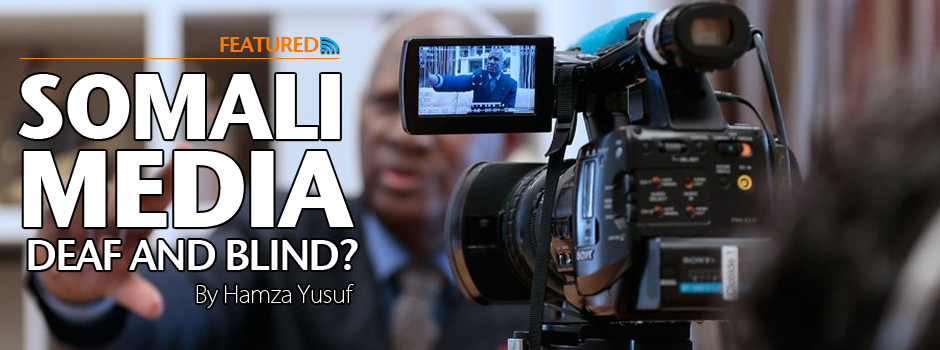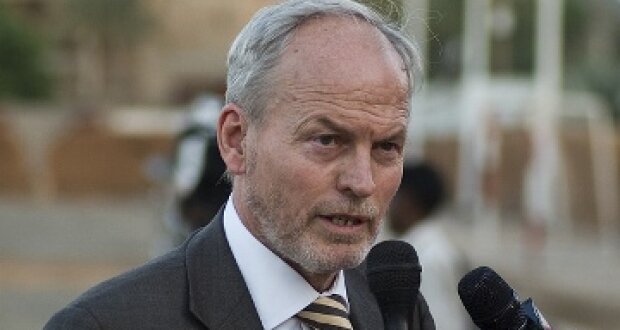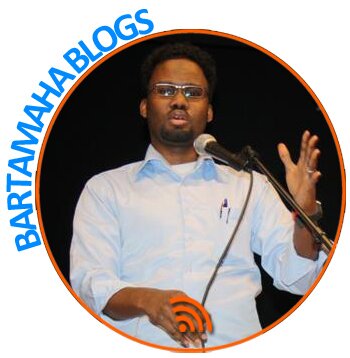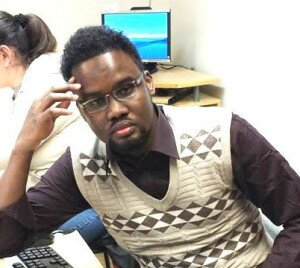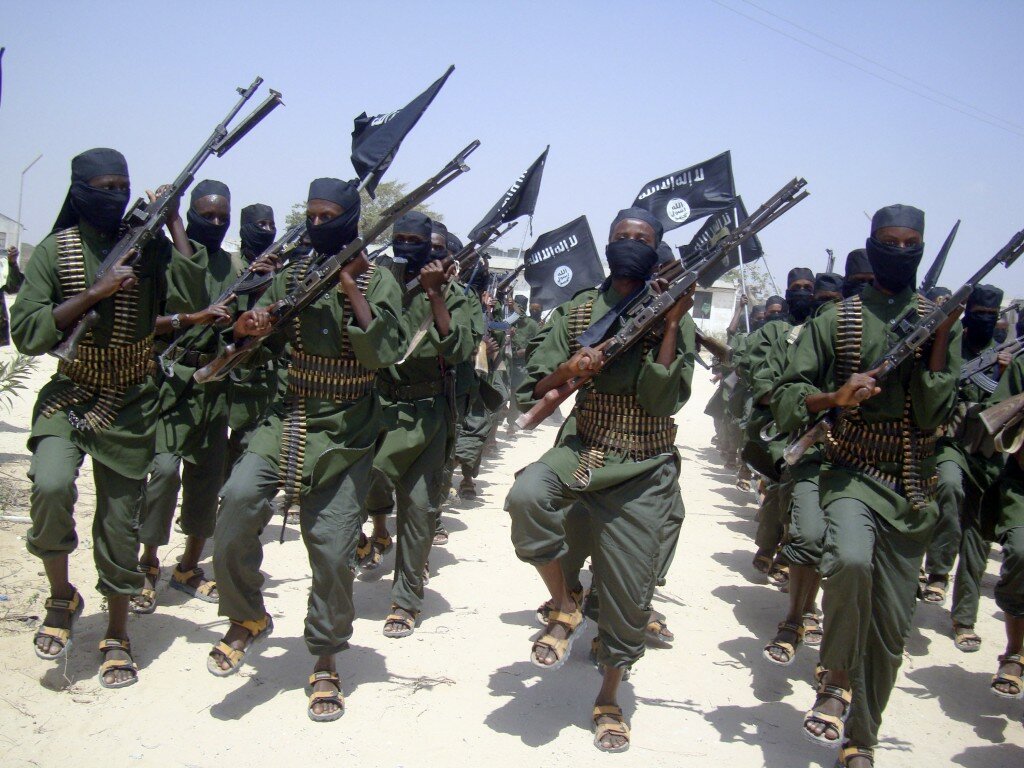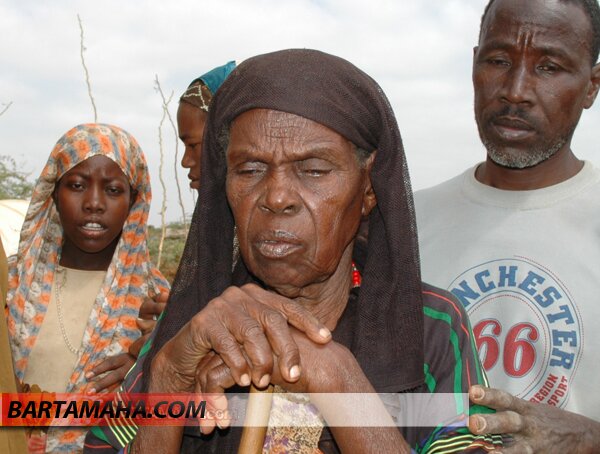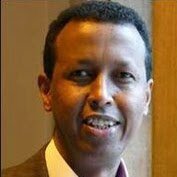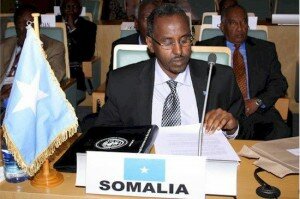Somalia’s Catastrophic Famine: POLITICAL DROUGHT OR NATURAL ONE?
 First I like to distinguish the connotation of the phrase political drought from A-Shabab’s argument that the current famine is politically motivated. Here by political drought I mean political barren situation that totally failed to resolve the twenty-year-old endless conflict, mayhem, misery, social fragmentation and reconstruct our fallen state that in turn have dried up the Somali people’s actual and potential human and material wealth and capability and eventually resulted in the current abject and widespread poverty in our country in general and unprecedented rampant catastrophic famine situation decimating our people today in particular.
First I like to distinguish the connotation of the phrase political drought from A-Shabab’s argument that the current famine is politically motivated. Here by political drought I mean political barren situation that totally failed to resolve the twenty-year-old endless conflict, mayhem, misery, social fragmentation and reconstruct our fallen state that in turn have dried up the Somali people’s actual and potential human and material wealth and capability and eventually resulted in the current abject and widespread poverty in our country in general and unprecedented rampant catastrophic famine situation decimating our people today in particular.
In this piece of writing, I examine and comment on the various aspects of the political drought which has been afflicting our country for so long and has eventually caused the grinding and widespread poverty in general and the current catastrophic runaway famine and I conclude with some recommendations.
Unpreparedness for the Famine
It seems that the TFG, UN, INGOs and governments around the world were caught unawares by the harrowing and heart-rending scenes and stories of the stream of famine stricken hundreds of thousands of skeleton and dying children, women and elderly people from Somalia to the Dadaab and Dolow Addo camps in respectively in Kenya and Ethiopia whose many of their family members and relatives who could not make the long journey inside Somalia or perished on the way or the similarly famished other hundreds of thousands flocking into to Mogadishu from adjacent regions. The UN could have predicted and intervened earlier before the situation went out of hand as it is today. Let alone to forecast this catastrophic famine and act in time, even the permanent 2.65 million figure of people in dire humanitarian situation in Somalia was cut back 2 million people in 2011’ for lack of funding perhaps due loss of interest in Somalia or aid fatigue by the donors.
For most Somalis and those who have been closely observing the twenty-year-old Somali tragedy including the UN, this runaway famine should have not been a surprise as they were living in or following the steady build-up of the adverse conditions which have been giving rise to the grinding and widespread poverty in Somalia over these years in general and this rampant famine in particular. In late June 2011, as an early warning I told a western official that ‘most Somali population is in imminent danger to perish for famine unless the world quickly intervenes’ but although he not so was convinced of my warning he promised that he would pass the message to those in positions of power. After two weeks the world was caught in surprise by the floods of famished hundreds of thousands to Mogadishu and to Dadab and Dolow Addo camps in the Kenyan and Ethiopian border regions. The TFG has not predicted this catastrophic situation either. It was too late and that is why unknown many thousands of lives are thought already perished inside Somalia.
Obstructed and Dwindling aid, Conflict and Drought
In the last couple of years humanitarian either obstructed by A-Shabab in parts of central regions and entire southern regions in 2010 and 2011 or it has been dwindling. For example, international humanitarian budget allocation for Somalia in 2009 US$900 million and for 2010 it was US$689,008,615 with ‘a reduction in the number of projects and a 19% reduction in requirements compared to 2009.’ A Mid-year Review of the UN CAP Somalia 2010 Report adds that ‘The revised Consolidated Appeal for Somalia seeks US$596.1 million to address the most urgent humanitarian needs in Somalia in those areas that agencies and their partners can reach. This figure is a 13.5% reduction from the original requirement of $689 million. As of June 25, US$338.8 million (56%) of funding had been recorded against revised requirements, leaving unmet requirements of US$262.3 million,’ and for 2011 it was US$529,520,029 less than 11% of financial requirements compared to 2010.’
The economy was steadily being destroyed and devastated by multiple factors such as Somali insurgents, authorities, external military interventions and drought. At the end of 2009 the UN described a gloomy situation unfolding in this way ‘protracted conflict, economic collapse, and drought conditions continued to drive the humanitarian crisis in Somalia in 2009 . . . resulting in increased population displacement, greater urban vulnerability and widespread acute malnutrition’ and ‘during the same period, internal displacement also increased by 16%.’
Food and Price hyperinflation and Reduced Remittances
The plight economy plight and current consequential lethal famine was also partly caused by the unprecedented monetary hyperinflation and skyrocketing of food prices afflicting the Somali economy and ruining the living standards of the Somali population in recent years. For instance, 1 S.Sh. 13,000 exchanged US$1 in 2006 while today S.Sh. 35,000 buys US$1.
Food prices have been affected by similar hyperinflation which also began during the occupation of the Ethiopian military and continued to rise due the economic collapse caused by such occupation in Mogadishu and adjacent regions. In addition, the remittances from the Diaspora, normally over $1 billion per year, are down by 25% due to the global recession.’
In Somalia food prices rose up at record levels between ‘100 – 160% in 2007 and 130–190% in 2008. Today price hyperinflation stands 450–780% above the long-term trend while the price of basic items such as eatable oil and sugar soared significantly and sorghum and maize prices increased by 180% and 107 respectively in Mogadishu in 2011.– the highest in all countries in 2011.
On 20 July 2011 the UN recognised and Mr. Mark Bowden the Humanitarian Coordinator for Somalia declared southern regions, namely, Bakool and Lower Shabelle as famine struck areas and that across the country, nearly half of the Somali population – 3.7 million people – are now in crisis, of whom an estimated 2.8 million people are in the south. Since then the UN extended the famine stricken regions to another six, namely Gedo, Lower Middle, Middle Shabelle, Bay, Mogadishu, Afgoi corridor of IDPs community stating that ‘in total 4 million people in are in crisis in Somalia, with 750,000 people are at risk of death.’ On 17 August 2011, British secretary of Department International Development stated that ‘400,000 children were at risk of death’ and ‘three-quarters of a million people are facing death by starvation in Somalia’ ‘tens of thousands of people have already died, over half of whom children.’ ‘During July and August, FSNAU conducted 34 representative nutrition and mortality surveys across southern Somalia, including 30 among local populations and four among internally displaced populations. Results from 24 surveys are available. Based on the most recent data available for each region, the average GAM prevalence was 36.4 percent and the average severe acute malnutrition (SAM) prevalence was 15.8 percent. The highest recorded level of acute malnutrition is in Bay, where the GAM prevalence is 58.3 percent. The U.S. Centers for Disease Control (CDC) has verified these findings’.
WHO has added that ‘more than 4,272 cases of acute watery diarrhoea and cholera have been reported in Mogadishu’s Banadir Hospital alone since January this year. Our major concern is to monitor and detect new disease outbreaks in the many informal settlements set up by internally displaced people in and around Mogadishu,” and that health agency was preparing for a potential 100,000 cholera cases, 80 percent of which will be moderate cases.’
But it should also borne in mind that many other parts of Somalia such as the central regions, and parts of Puntland and Somaliland, where the Gu’ rains were little or very patchy, millions of people have already been affected by the effect of drought and grinding poverty they are in. So, the UN and INGOs should now get prepared for a similar of starvation or famine if the Deyr rains fail or fall short. In any eventuality, the most people in these parts are afflicted by abject and widespread poverty due to loss of their livestock and price hikes over the years and they badly need humanitarian aid any time.
Generous but late and inadequate global response
The global media highlighted this Somali plight more than they have done in recent years during which the conditions that gave rise to this calamity were in the making. Somali individuals and organisations inside and outside the country have shown extraordinary solidarity of brotherly and sisterly hearts, minds and made material donations. Also UN agencies, INGOs and governments are around the world have similarly responded with whatever sympathy and humanitarian donations could. But all such generous donations are insufficient given the large scale of the famine.
The UN CAP Somalia for 2011 including the current famine situation was $1,062,743,765 of which $641,105,711 was received which is 60.33% while $421,638,054 or 39.67% contributed by the rich western and Muslim countries spearheaded by Turkey while various Somali individuals and organisations inside and outside the country donated millions of dollars in cash and kind to their famished brethren. It is that noteworthy that kind donations came from unexpected directions such as presidents of Equatorial Guinea and Gambia, the Hamas authority in besieged Gaza and Jewish community in Canada respectively donated $1 million; $2, $140,000; $25,000 and $62 million by Ikea the Swedish Furniture company whose donation is higher than most western countries to name a few. These generous contributions of solidarity regardless of race, creed and politics epitomise the common humanity between mankind. However, these generous contributions came late to save the lives of tens thousands who have already perished and fall short to cover the runaway famine and poverty existing n the country.
Problems of Discrepant and Incorrect Population Figures
UN statistics put Somali population at these discrepant and obviously incorrect figures as there is negative or almost annual population growth or sudden wipe-out of millions of people:
• 9,891 million people in 2003 (UN DESA June 2004)
• 8,228 million people in 2005 (UN Stats) or 6.799 million by Food and Nutrition Division, FAO, 2005
• 8,926 million people in 2008 (UN Stats),
• 7,502 million people in 2009 (UN Stats),
• 7,502 million people both in 2010 and 2011 (UN CAP Report on 5/9/2011) and again
• 9.100 million people in 2011 (UNHCR)
But we know that Somaliland and Puntland each put their respective population numbers at 3.5 million. and 2.4 million totalling 5.9 million people. What about the population of central and southern regions including the capital Mogadishu? Can it be less than 10 million people? in which case the Somalia’s population inside the country could be about 16 million people excluding the 2-3 million people in the Diaspora. This figure more or less corresponds to the guesses and gut feelings of the Somali public. These unsettled population numbers is part of the problem because many destitute or starving people are always left out in the statistics and related planning and provision of humanitarian and development aid by the international community. So, the UN and other external projects and calculate their intervention in Somalia on these. This brings to mind the question, are the 4 million people declared by the UN as famine stricken represent the real number of people in dire? Nobody can find out this unless there is correct or reasonable figures of the Somali people are put in place. But there is no doubt that a great number of Somalis in need are missed out in these calculations.
Concealment of extent of Somali
famine in East Africa Context
Whenever there is a drought or famine it has become a common practice for the UN and international community to lump Somalia with the other East Africa countries and that conceals the true extent and severity of the starvation and famine of the population in Somalia. It is real that the Horn of Africa especially Somali populated part is an arid and semi-desert land with less rainfall and prone to frequent droughts but unlike Somalia in other East African countries there are stable and well functioning governments whose economies is doing well and can normally feed their populations or tackle droughts. Despite this fact, the UN and IC treat the drought and famine situation that strike quasi-stateless Somali population whose economy is shambles in the same way as the other East Africa cases or even less. For example, Mr. Brendan Gormley, Chief Executive of Britain’s Disasters Emergency Committee (DEC), told Channel 4 News that Britain ‘had raised £57m pounds for the Horn of Africa Appeal. . . only 27 per cent of the money will be allocated to Somalia with over 70 per cent going to Kenya and Ethiopia.’
Somalia is in the grips of exploded catastrophe which is a result of accumulated disasters of the twenty-year-old brutal and endless civil war conflict especially in the capital Mogadishu and central and southern regions that destroyed the wealth of the urban population, recurrent severe drought which decimated over half of the pastoralists’ livestock and made framers almost impossible to produce their food, lack of effective government to intervention and mitigate disastrous manmade and natural calamities. Given these circumstances, this widespread and acute catastrophic famine explosion was inevitable and expected one by most Somalis and all those who care about Somalia’s protracted plight slowing and surely decimating the Somalia population and endangering its existence as a viable nation if such permanent massive death, destruction, displacement, flight of refuges, grinding and rampant caused by political and natural drought continue.
Ingredients of the Political drought
The prolonged political drought in Somalia, of which the ingredients are outlined below, manifests itself into the current unprecedented famine situation in particular and the grinding and widespread poverty existing in Somalia in general:
• deaths of thousands of young reproductive and productive labour force have been killed or maimed by weapons while hundreds of thousands diseases, and starvation/famine mostly the able-bodied male work force and breadwinners.
• massive and systematic destruction of the nation’s public and private wealth and displacement depriving and dispossessing millions of people of their basic entitlements livelihoods and dispossession in the above regions which in many ways in ssouth/central regions also indirectly adversely affecting Puntland, Somaliland, and ethnic Somali population in Kenyan Northern Eastern Region and Ethiopian Somali Region Five of which the economy is closely interlinked and largely dependent on Somalia.
• Destruction of the Bakaraha Market in Mogadishu of Mogadishu on which the economy of Somalia and to some extent neighbouring countries’ first by the 2006-2009 Ethiopian military intervention and secondly by Al-Shabab/ TFG/Amisom forces.
• Humanitarian relief aid dependency which over these years has been mouth-feeding the those dispossessed millions and caused many more to abandon their self-sustaining, productive occupations such as farming and animal raising creating dooming dependency.
• The extremist A-Shabab movement’s trade restrictions, extortions and ban of international humanitarian relief and development aid in the regions under their control that caused current rampant and acute famine in the southern regions.
• Warlords or nominal transitional governments during the last two decades which could not establish peace and security in the Mogadishu city or much less to reach out and expand their authority the whole country or intervene in to tackle or alleviate the manmade and natural disasters out there.
• Uncared and unmitigated continuous desertification and severe environmental degradation caused among other factors by cutting of trees for charcoal export contributing to failure rains, decrease of ground water, agricultural crops, pastures and loss of flora and fauna.
• Spectacular failure of Somali leadership elites unable to rise above tribal loyalty, selfishness, indifference, opportunism, passivism, factionalism and to reassert their sense of patriotism and create national political organisations to be able to address the prolonged agony of their nation and reconstruct their collapsed state.
• Buffer zone wars waged by Somali militias supported by certain neighbouring countries in Somalia’s borders areas in several regions such as Galgadud, Hiiraan, Bakool, and Lower Jubba that seem having no any other objective but to protect the security of these countries while resulting in hundreds of deaths, destruction of massive peoples’ properties, their displacement in the tens of thousands with the end result of constant human agony and misery.
• The international community’s (IC) several interventions since 1992 which failed to help resolve the Somali protracted conflict and disastrous aftermaths for one reason or the other while they did resolve the conflict of Bosnia Herzegovina, Liberia, Sierra Leone, East Timor, etc.
• Imposition of arms embargo on the TFG government and another Somali authorities to fight against those who are driving the conflict like A-Shabab whereas arms are provided to warlord groups by some members of the IC and A-Shabab get arms or money to buy them from their allies.
• IC’s neglect to resolve the Somali conflict and crisis and instead of application of deadly policy of containment which means to confine its conflict within Somalia’s borders to protect the neighbours and the world participated by at least 100 states represented in the International Contact Group or involved in one or the other. There are also other several other states such China, Russia, India, etc. which participate in the naval armadas ‘fight against piracy’ off the Somali coastal waters which are part of the ‘containment’ forces.
Therefore, the current unprecedented famine which affected most of the Somali population cannot be attributed to drought only but the end result of cumulative disasters amounting to this catastrophic famine caused the by the above listed manmade problems which can be described as political drought. Over the last twenty years or even well before, these manmade problems have exhausted the wealth and power of the Somali nation – institutions, values, lives hundreds of thousands youngsters and able-bodied men who today would be the reproductive and productive of the nation; properties – money or kind, livestock, farm produce, and incalculable means of livelihoods and survival strategies of storing provision for bad times and traditional welfare system which were all based on the above listed lost or strained means of sustenance of the nation.
The Gridlocked UN deadly Containment policy of Somalia
The following diagram show the political drought that grips Somalia and its people which I call gridlocked UN containment policy nails down Somalia and if not lifted helps its permanent disintegration as nation-state.
Diagram of UN Gridlocked Containment policy of Somalia
Look carefully at this gridlock or entanglement diagram of containment over Somalia participated by at least 109 (27 EU states + 1 USA + 1 Canada + 1 Switzerland + 54 AU states + 22 Arab League states + 1 Japan = 107 + China + 1 Russia which two are Permanent Veto owning UN Security Council members = 109 states.
• Look at the arrows going forth and back between many international organisations and Mogadishu/TFG.
• Look at how Mogadishu/TFG are disconnected from the rest of the country.
• Look at the arrow which bypasses Mogadishu/TFG and going forth and back between the UNPOS (UN Political office for Somalia) and Somali regions.
• Look at the arrows going forth and back between the individual countries and Somali regions bypassing the Mogadishu/TFG.
• Look at the rectangular figure representing A-Shabab controlled central/southern regions disconnected from the Mogadishu/TFG and the UN but connected to individual countries and organisations.
This system or model of governance is strange one. It is not national Somali system, it not an officially declared UN led one geared to overcome the Somali crisis, it not an AU led one also meant to resolve the crisis, it is not a direct and declared colonial one led by one colonial state or group of states. Similarly, it is not clear on whom the ultimate responsibility and accountability lie. It is the UN, Au, IGAD, AMISOM trooping contributing countries which are Uganda and Burundi? It is the International Contact Group which periodically convenes and reaches decisions for Somalia but does implement them? It TFG which has inadequate human and material resources including enough and capable security forces and depends one above named organisations? The answer is there nobody which has the ultimate responsibility and accountability. The Ic often blames the TFG leadership without giving them sufficient support and freedom to manoeuvre to plan and their business independently.
The diagram shows how body of Somalia is cut into pieces: the head (Mogadishu + TFG) is cut off and taken care by at least 109 countries and the belly and limbs (Somaliland, Puntland, Galmudug, and central/southern regions) are also cut off from the head with no connecting flesh, bones, veins, tendons, organic (social, legal, economic, or administrative linkages) to the head! It is like a scene of corpse scavenged by all the carnivorous predators and insects. This is the Somali Government recognised by the international community (IC) and UN. This is what mean by deadly containment policy of Somalia and political drought taken by the IC primarily the major western powers and UN which is literally their long arm.
Is this lethal containment intentionally planned or is it an accidental outcome so administered by the UN and IC? I think it is bit of both. The Somali conflict dragged for a long time, the IC intervened in 1992-1995 but had withdrawn because of failure stemming from ill-planned and ill-advised intervention policies in the first place. Then becoming disappointed, the IC abandoned and neglected Somalia for about a decade attending other conveniently important missions such as those in Iraq, Bosnia, East Timor, Liberia, Sierra Leone, Afghanistan, again Iraq, etc. Then after the destruction of the World Trade Centre Towers on 9 September 2001 by terrorists, the ‘War on Terror’ began and US President Bush (Jr.) included Somalia his global tapestry of this war because of his administration’s concern about the presence in Somalia of certain terrorist elements believed to have had a role in the bombings of the US embassies in Kenya and Tanzania in 1998 and existence of growing Islamic fundamentalist groups in Somalia.
Then started, at least from 2006, President Bush’s ‘war on Terror’ proxy interventions and containment policy against Somalia. Somalia is till applied such ‘war on terror’ in a silent and inactive form which the above described killer containment represents. So this unfortunate situation which is a product of the Somali turmoil and the Bush’s counterproductive policy that US President Barack Obama’s Administration failed to review and change it positively despite his high-flown promises that he would demolish the walls of injustice and bad policies around the world.
The above described model of TFG enmeshed in a web of containment that is absolutely no workable system. Neither the Somali TFG leaders nor the IC, nor the UN can make it function. So, it is unfair to criticise Somali TFG leaders to make work this model entangled by the robs of over 100 countries and the UN unless it is disentangled and containment policy lifted. This means a thorough review, abandonment of this static model, and changing it with a new policy and model that can work.
Turkey broke a section of the deadly Containment wall
©Somalia Report Erdogan (right) with Somali president 19 August2011
The historic decision and visit to Mogadishu by the Turkish Prime Minister Mr. Dayid Erdogan have broken a section of the deadly wall of containment behind which Somalia is slowly dying. Also by organising the Summit of the Organisation Islamic Cooperation (OIC) countries in Istanbul on 18 August, he gave a heart to the timid and head flicking Arab and Islamic to dare and reach out to help the Somali people in this situation of live and death they are in which donated a considerable sum of $350 million out of which Turkey paid $150 million. He also promised to undertake several quick humanitarian and development aid practical measures like such as: a) rehabilitating and equipping dilapidated Martino Hospital and staffing doctors and nurses, b) rebuilding the also road linking the Airport the Presidential Palace, c) offered much appreciated 500 scholarships to Somali students of which many were already transported by Turkish planes to Turkey, d) provision of considerable continuing humanitarian aid, etc. None of the 100 states or so (Au, EU/IGAD, AL, EEA, North America, etc. grouped in ICG and UN Security Council), which take care of the containment policy over Somalia, could not do anything like this vital quick development projects promised and started by the Turkish Government of PM Erdogan in a matter of few weeks.
In actual fact, Prime Minister Erdogan did not only break a section of wall deadly containment but he also set in motion and gave new lease of life to the dispirited and stagnated Somali politics. Bravo brave Erdogan! Somali people owe you and your people a great and unforgettable gratitude! On the part the other Muslim fellow leaderships ought to emulate PM Erdogan exemplary actions to help deliver the Somali nation from the protracted conflict, mass starvation and famine circles, widespread poverty and lack of functioning central government. The $350 million donated by the IOC countries is more than half the $641,105,711 international funding so far confirmed by the UN which means that the former western rich countries paid more than the rich western perhaps due to their current economic doldrums.
Lack of Counting of Somali death toll and Impunity
‘The UN and INGOs counted the 1992 major Somali famine in the so-called ‘Death Triangle’ of Bay, Bardera and Jilib’ as nearly 300,000 innocent people starved to death’ because of clashing factional politics. But since there no figures counted and publicised by UN and other agencies although millions of people have perished due to unabated conflict and repetitive severe drought resultant starvation/famine and diseases. Meantime the death of conflicts and natural calamities in countries are counted and made public the UN, INGOs and some of the interested governments. Why Somali death toll is not being counted and publicised? Also perpetrators of crime against or genocide in other parts lof the world are incriminated and are brought to justice, why the UN Security Council and other international crime justice bodies do not address the problems of crime against humanity and violations of human rights in Somalia and condone to the impunity by Somali and foreign culprits?
Who is to blame?
I think, as indicated above, the blames lies squarely on both the Somalis and the international Community. The Somalis, I mean the leadership elites, have resolved the problem of the country long time ago. But since they failed in their national responsibility, the IC should have helped the Somalis solve their crisis out of humanity as they did for other broken countries. But apparently they too failed to do so. So, he blames lies on both and these failures carry not only blames but culpability for both sides as they are part of the problem.
For example, there always have been comments by Somalis and foreigners about the Somali endless conflict and human rights violations, humanitarian catastrophe and misery affecting the Somali nation. About the cause of this particular famine, one Somali academic ascribes the cause of this runaway lethal famine to ‘callous uses of military and political power by all actors against poor people have produced a catastrophic famine’ which he terms ‘crime against humanity’ driven by geopolitics considerations (in his Genocidal politics and the Somali Famine by Prof. Abdi I samatar, August 01, 2011 Article in Aljazeera 30/7/2011).’ A foreign scholar also defines this famine as ‘Crime against humanity’ attributing its cause to A-Shabab movement ( Jens David Ohlin comments at CNN 12/8/2011 terms this famine as associate prof. of law at Cornell Law school. Another Somali scholar blames on A-Shabab for largely contributing the present deadly famine in south Somalia by their actions of a) preventing international humanitarian aid, b) Somali individuals and agencies and c) TFG to provide humanitarian relief and development to the population under their control which are now catastrophically hit mass famine. On 6/9/2011 Hassan Shire of chief East Africa Human Rights organisation based in Uganda in an interview with UNTV senior Correspondent Abdisalam Harari. Ajjazeera criticises UN by glossing over the situation 6/9/2011.
Encouraging thin Political Clouds
After 20-year long period of political drought which almost exhausted the physical, spiritual and material wealth of the Somali nation, despite the current widespread deadly famine, there have been some thin positive clouds in recent months which may or may not rain such as:-
• Sense of confidence and national pride and relatively better performance displayed by former TFG Prime Minister Mr. Abdullahi Farmagio’s short-lived (6 months) cabinet and the same is expected from prime Minister Prof. Abdiweli M. Ali Gas’s government.
• Signs of nationalism awakening and patriotism among the Somali people both inside and outside the country and growing realisation that the resolution of our crisis of there is primary responsibility that cannot be expected and waited from external actors.
• The expansion of the area of control of Mogadishu by the TFG with the support of AMISOM.
• The retreat of a-Shabab fighters from most of Mogadishu city on 6/8/2011.
• President Sheikh Sharif’s visit to Garowe, Puntland’s regional capital after three years of his ascension on the presidency and mending the relations with the Puntland leaders and people was a good step which should have come earlier.
• The Holding of the High Consultative Meeting in Mogadishu instead of foreign capitals and endorsement of the TFG Tasks of the remaining year of its life although some Somalis feel that they were excluded.
• The history visit of the Turkish prime Minister on in Mogadishu and substantial relief and development aid his government offered to Somalia especially Mogadishu and adjacent regions, and
• The Second Round of the High Consultative meeting to be held in Garowe, Puntland.
Will these encouraging thin political clouds rain? It is unlikely that these they will rain to do away the long-running political drought in the present entanglement or containment policy Somalia is under? But let’s hope so.
Recommendations:-
To Somali Transitional Federal Government (TFG):
• To face the bitter truth that the current model of governance on which the TFG is based is not working now and in the future and it is imperative to think about and come up with alternative system.
• To realise the hard fact that without our own national armed or security forces we neither restore peace and security nor our independence and sovereignty. So start from now on to training ordinary soldiers inside the country.
• To capitalise on the important support of the Turkish Government and Arab governments which can forward in terms of rebuilding security forces, civilian institution, and socio-economic reconstruction by engaging proactively and reaching agreements with them because they have the will, financial, economic, and technical means.
• To Talk to A-Shabab and seek their reconciliation and stopping the conflict offering true and reliable promise and incentives that they will be part and parcel of the new Somalia to be rebuilt. If they refuse, make your own plans to confront them in everywhere in the country they are found.
• support proactively and work with participatory democracy of bottom-up and decentralisation approach of consulting and empowering people at the grassroots – villages districts, regions to play their roles of in peace-building and reconciliation, state-building and socio-economic reconstruction of the country in a way that these bottom-up activities connect the top-up approach which have hanging from the air the last two years.
• Place national and common interest above your personal and group interest and be just/fair, transparent and accountable in all your actions.
To the International Community of States and UN
• The International community (states involved in Somalia) have to stop the individual contesting and contradictory policies and come up with concerted policy of positively helping Somalia to recover from the ruins.
• To review as soon as possible the jettison overboard the deadly containment and neglect policy and current model of governance confined in Mogadishu walls (TFG model) that Somalia has been imposed for so long and change it with fresh humane, proactive policy of helping the stabilisation, reconstruction and reunification of Somalia in a way that Somalis have the ownership of which outcome could a win-win for all.
• To start and help build the Somali security forces (army, police, etc.) because without trained and equipped capable reliable national forces neither the security nor the sovereignty of Somalia can be restored to replace the temporary peace-keeping or enforcement.
• To stop the policy of condoning to or ignoring the A-Shabab problem and help in a coordinated the Somali TFG, concerned regions and people with the necessary means to deal this and remove this malignant problem without further.
• To provide incentives training skills and employment creating projects to the pirates and for sure they will stop the piracy activities at sea.
• The longer the current policy of neglect and containment, the more the Somali people perish for famines, poverty and diseases, the country disintegrates forever and extremism flourishes. So, it is imperative to act now and shift the paradigm in a right and effective way.
______________________________________________________________________________
Author: Omar Salad, BSC (Hons.), DIPSOCPOL, DIPPOLGOV
He can be reached at [email protected] 20/9/2011
Comments
comments
 Calendar
Calendar





